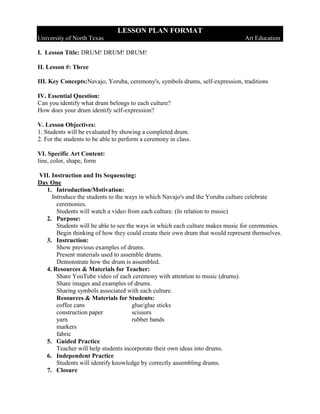
Lesson 3: Yoruba & Navajo Drums
- 1. LESSON PLAN FORMAT University of North Texas Art Education I. Lesson Title: DRUM! DRUM! DRUM! II. Lesson #: Three III. Key Concepts:Navajo, Yoruba, ceremony's, symbols drums, self-expression, traditions IV. Essential Question: Can you identify what drum belongs to each culture? How does your drum identify self-expression? V. Lesson Objectives: 1. Students will be evaluated by showing a completed drum. 2. For the students to be able to perform a ceremony in class. VI. Specific Art Content: line, color, shape, form VII. Instruction and Its Sequencing: Day One 1. Introduction/Motivation: Introduce the students to the ways in which Navajo's and the Yoruba culture celebrate ceremonies. Students will watch a video from each culture. (In relation to music) 2. Purpose: Students will be able to see the ways in which each culture makes music for ceremonies. Begin thinking of how they could create their own drum that would represent themselves. 3. Instruction: Show previous examples of drums. Present materials used to assemble drums. Demonstrate how the drum is assembled. 4. Resources & Materials for Teacher: Share YouTube video of each ceremony with attention to music (drums). Share images and examples of drums. Sharing symbols associated with each culture. Resources & Materials for Students: coffee cans glue/glue sticks construction paper scissors yarn rubber bands markers fabric 5. Guided Practice Teacher will help students incorporate their own ideas into drums. 6. Independent Practice Students will identify knowledge by correctly assembling drums. 7. Closure
- 2. Discuss and share how they will choose to portray their ideas on his or her drum. 8. Formative Evaluation Students will be assessed on different terms, such as: Navajo, Yoruba, ceremony, drum making, line and color. 9. Classroom Management Procedures Students will sit in their seats during demonstration. Materials will already be placed on tables prior to student’s arrival. Each group table will be assigned "CLEAN UP CHORES" where different supplies should go and where to store their project. Day Two 1. Introduction/Motivation: Review and discuss different ceremonial traditions in the Navajo and Yoruba culture. Review symbols that can be used to decorate drum. 2. Purpose: Students will begin and complete designing drums. Students will perform a ceremony celebrating life. 3. Instruction: Present materials used to decorate drums. Allow students time to design their drum that they will play in ceremony with. Organize ceremony to be done with students. The teacher and students will both dance and play their drums. 4. Resources & Materials for Teacher: Examples of drums Resources & Materials for Students: markers crayons construction paper glue scissors 5. Guided Practice: Teacher will organize ceremony similar to the studied cultures. 6. Independent Practice: Students will dance and play their drums in an orderly fashioned manner. 7. Closure: Discuss and share how they will be able to play their drum in the ceremony. 8. Formative Evaluation: Have students made a drum to be presented in the ceremony? 9. Classroom Management Procedures: Students will seat in their seats while completing design for drum. Materials will already be placed on tables prior to student's arrival. Each group table will be assigned "CLEAN UP CHORES" where different supplies should go. Students will gather in a circle and put on ceremony. The teacher will lead and guide them to beginning and ending the ceremony. Students will give to teacher to be displayed. VIII. Summative Assessment and Evaluation: Did they incorporate their own identity into their drum? How effective was their use of self-expression? Did they take part in the class ceremony?
- 3. X. Interdisciplinary Connections: History and Art Navajo and Yoruba Culture XI. References & Resources: Images of Yoruba and Navajo drums YouTube of Navajo & Yoruba playing drums Library resources XII. Art TEKS Art, Grade 4/5 (a) Introduction. (1) Four basic strands--perception, creative expression/performance, historical and cultural heritage, and critical evaluation--provide broad, unifying structures for organizing the knowledge and skills students are expected to acquire. Students rely on their perceptions of the environment, developed through increasing visual awareness and sensitivity to surroundings, memory, imagination, and life experiences, as a source for creating artworks. They express their thoughts and ideas creatively, while challenging their imagination, fostering reflective thinking, and developing disciplined effort and problem-solving skills. (2) By analyzing artistic styles and historical periods students develop respect for the traditions and contributions of diverse cultures. Students respond to and analyze artworks, thus contributing to the development of lifelong skills of making informed judgments and evaluations. (b) Knowledge and skills. (1) Perception. The student develops and organizes ideas from the environment. The student is expected to: (A) communicate ideas about self, family, school, and community, using sensory knowledge and life experiences; and (B) choose appropriate vocabulary to discuss the use of art elements such as color, texture, form, line, space, and value and art principles such as emphasis, pattern, rhythm, balance, proportion, and unity. (2) Creative expression/performance. The student expresses ideas through original artworks, using a variety of media with appropriate skill. The student is expected to: (A) integrate a variety of ideas about self, life events, family, and community in original artworks;
- 4. (B) design original artworks; and (C) invent ways to produce artworks and to explore photographic imagery, using a variety of art media and materials. (3) Historical/cultural heritage. The student demonstrates an understanding of art history and culture as records of human achievement. XIII. National Art Standards 1. Understanding and applying media, techniques and processes 2. Choosing and evaluating a range of subject matter, symbols and ideas 3. Making connections between visual arts and other disciplines
